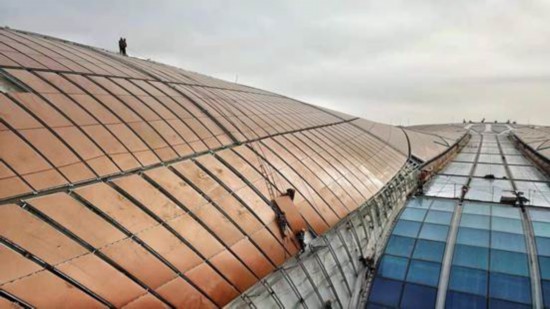Beijing Daxing International Airport opened to flights on September 25th, 2019. Shaped like a phoenix spreading its wings, the new airport is considered to be the largest single air traffic hub, probably also the most difficult to build in the world. To support its phoenix-like appearance, a technical team of Professor Chen Zhihua, Professor Liu Hongbo and Associate professor Wang Xiaodun from the Steel Structure Institution of Tianjin University’s School of Architecture Engineering conducted a full-scale test on mass and complex welded hollow spherical joints and discovered the fracture mechanism of the joints and their load-bearing capacity, thus providing critical technologies to construct the framework of the “phoenix”.

The roof of the airport under construction
The phoenix-like roof of the aviation hub is a reticulated structure of large span and irregular spatial curved surface, and has been most difficult to build since it has exceeded the existing specification limits in both length and span. The current welding hollow spherical joint technique applied to the steel structure of the air hub’s roof top, as Professor Liu Hongbo introduced, was originally developed independently by Professor Liu Xiliang and his group from Tianjin University in 1965 and has become one of the most widely used joint technique in spatial reticulated structures.

Beijing Daxing International Airport
During the design and construction of the new airport, the TJU team strove to make technical progress in two aspects. Firstly, spheres whose diameters exceed 800 mm, triple the diameter of a basketball, are adopted. In previous cases, the diameter of spheres are usually below 500mm. Secondly, the design required that the lower part of the spherical structure should look like a plane surface rather than a curved one when viewed from the inside. To achieve this effect, the team devised an innovative drum-shaped welding hollow spherical joint design, carried out research and experimentation on the new design’s mechanics performance and load-bearing capacity, and eventually provided a safer and easier way to build the steel framework for the airport roof while maintaining its aesthetics.
By: Zhu Xiyu
Editors: Eva Yin & Doris Harrington






